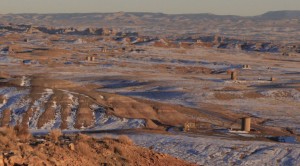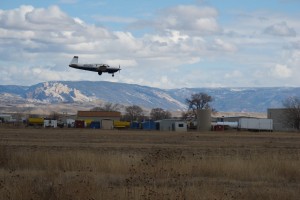9 August 2013
Scientists observe significant methane leaks in a Utah natural gas field
By Katy Human
On a perfect winter day in Utah’s Uintah County in 2012, researchers tested out a new way to measure methane emissions from a natural gas production field. Their results, accepted for publication in Geophysical Research Letters, a journal of the American Geophysical Union, constitute a proof-of-concept that could help both researchers and regulators better determine how much of the greenhouse gas and other air pollutants leak from oil and gas fields. The measurements show that on one February day in the Uintah Basin, the natural gas field leaked 6 to 12 percent of the methane produced, on average, on February days.

Equipment associated with natural gas exploration and development dots the landscape in Utah’s Uintah Basin. CREDIT: David Oonk, CIRES
“We used a mass balance technique, which means we follow an air mass as it moves into the region and then flows out,” said Colm Sweeney, a scientist with the Cooperative Institute for Research in Environmental Sciences (CIRES) in Boulder, Colo.“We look at the difference in methane between those two to determine an actual emissions rate for the region.”
CIRES is a joint institute of the National Oceanic and Atmospheric Administration (NOAA) and the University of Colorado Boulder. Sweeney leads the aircraft group at NOAA’s Earth System Research Laboratory Global Monitoring Division.
CIRES, NOAA and other scientists have used this type of atmospheric mass balance accounting technique in many other settings—to determine power plant emissions, for example, and the atmospheric impacts of refineries and cities, said Anna Karion, lead author of the new paper and a CIRES atmospheric scientist who also works at NOAA.
In Utah’s Uintah Basin, on one day during a weeks-long field campaign in 2012, weather conditions were near ideal for testing the technique in an oil and gas field, Karion said. Late on February 2, a weather front passed through, with high winds that swept clean the atmosphere above the Uintah Basin, south of Vernal, Utah.
“Then the next day, the winds decreased to about 12 miles per hour, and they held very steady for hours,” Karion said.
When the winds settled down on February 3, a pilot flew a single-engine Mooney TLS aircraft, carrying sophisticated instruments for measuring methane and other atmospheric gases, back and forth in the Uintah Basin. The aircraft measurements let scientists calculate the total amount of methane added to the air mass as it transited the basin. Combining those data with precise measurements of wind speed, made by NOAA colleagues using a ground-based laser, scientists could calculate the methane emission for the whole basin.
The team determined that methane emissions from the oil and natural gas fields in Uintah County totaled about 55,000 kg (more than 120,000 lbs) an hour on the day of the flight. That emission rate is about 6 to 12 percent of the average hourly natural gas production in Uintah County during the month of February.
A recent federal report estimated that methane’s leak rate, nationally, is less than 1 percent of production; another report noted that emissions in the Uintah (“Uinta”) Basin, which produces about 1 percent of total U.S. natural gas, may have higher emissions than typical for western gas fields. The Environmental Protection Agency’s Office of Inspector General has called for better emissions data from the natural gas sector, and this paper is one of the first published since.

A research aircraft comes in for a landing in Vernal, Utah. Sensitive instruments aboard let CIRES and NOAA researchers measure atmospheric levels of methane ¬ and other chemicals during flights through the Uintah Basin oil and gas fields, in Utah.
CREDIT: Sonja Wolter, CIRES/NOAA
The aircraft was part of a collaborative, multi-agency mission in the region to better understand how emissions from fossil fuel extraction activities affect local air quality. Methane is the primary constituent of natural gas, and it is a potent greenhouse gas. Other components, such as chemicals called volatile organic compounds are also emitted from oil and gas production operations and can contribute to ozone pollution.
“We expected methane emissions would be detectable, but we did not anticipate levels as high as what we observed,” Sweeney said.
The aircraft flew over the oil and gas field 11 other days during the study, but on those days, wind and other atmospheric conditions were unpredictable or erratic making it difficult to directly estimate methane emissions.
Karion, Sweeney and their co-authors continue to analyze methane and other emissions data gathered in Uintah Basin, in 2012 and 2013, and from recent scientific flights through other oil and gas production regions.
Utah’s Division of Air Quality helped to fund some of the Utah work, and Deputy Director Brock LeBaron said that new actions already taken by the EPA and the state of Utah will soon lessen methane emissions in the Uintah Basin.
“Our work with NOAA and CIRES indicates that high levels of volatile organic compounds contribute to ozone pollution in the Uintah Basin,” LeBaron said. “Our own efforts in Utah and the EPA’s oil and gas New Source Performance Standards, designed to lessen those air quality impacts, will also significantly cut methane emissions during the next few years.”
Coauthors of “Methane emissions estimate from airborne measurements over a western United States natural gas field” are Anna Karion, Colm Sweeney, Gabrielle Pétron, Gregory Frost, Jonathan Kofler, Ben R. Miller, Tim Newberger and Sonja Wolter of the Cooperative Institute for Research in Environmental Sciences at the University of Colorado Boulder; Robert Banta, Alan Brewer, Ed Dlugokencky, Mike Hardesty, Patricia Lang, Stephen A. Montzka, Russell Schnell, Pieter Tans, Michael Trainer and Robert Zamora of NOAA’s Earth System Research Laboratory in Boulder, Colo.; and Stephen Conley of the University of California, Davis.
— Guest blogger Katy Human is Communications Director of the Cooperative Institute for Research in Environmental Sciences (CIRES) at the University of Colorado Boulder.










 GeoSpace is a blog on Earth and space science, managed by AGU’s Public Information staff. The blog features posts by AGU writers and guest contributors on all sorts of relevant science topics, but with a focus on new research and geo and space sciences-related stories that are currently in the news.
GeoSpace is a blog on Earth and space science, managed by AGU’s Public Information staff. The blog features posts by AGU writers and guest contributors on all sorts of relevant science topics, but with a focus on new research and geo and space sciences-related stories that are currently in the news.